Welcome to your ultimate guide to the postal codes of Camiguin, the picturesque island province located in the Bohol Sea. Have you ever wondered why knowing the postal codes of different areas in Camiguin is crucial? How does it impact the efficiency of mailing and logistics? Let’s explore the importance of postal codes and unlock the secrets to hassle-free delivery.
Key Takeaways:
- Understanding Camiguin’s postal codes is essential for seamless mailing and logistics.
- Postal codes play a vital role in ensuring that mail and parcels reach their intended recipients in a timely manner.
- Properly using ZIP codes facilitates efficient delivery and enables accurate tracking and sorting of postal items.
- ZIP codes provide valuable data on a region’s population demographics, which businesses can leverage for planning and expansion.
- By using the correct format and including the appropriate ZIP code, residents and businesses in Camiguin can enjoy the benefits of an efficient postal system.
Overview of Camiguin Province
Camiguin Province, located in the Philippines, is a vibrant destination known for its stunning natural landscapes and cultural festivities. As the second-smallest province in the country in terms of both population and land area, Camiguin offers an intimate and idyllic escape for travelers seeking tranquility and natural beauty.
The provincial capital of Camiguin is Mambajao, a lively municipality that serves as the gateway to the province’s many attractions. Mambajao is not only the capital but also the largest municipality in Camiguin, offering a range of accommodation options, restaurants, and amenities for visitors.
One of the highlights of Camiguin is its picturesque volcanic landscape. The province is home to Mount Hibok-Hibok, a stratovolcano that attracts outdoor enthusiasts and trekkers from around the world. The challenging hike to the summit rewards adventurers with breathtaking panoramic views of the island.
Another must-visit event in Camiguin is the annual Lanzones Festival, a colorful celebration that showcases the province’s famous sweet lanzones fruit. During the festival, the streets come alive with vibrant parades, street dances, and various cultural performances.
Visitors to Camiguin can also explore its beautiful beaches, crystal-clear waters, and stunning underwater ecosystems. From snorkeling and diving to island hopping and sunbathing, there are endless opportunities to immerse oneself in the island’s natural wonders.
Whether you’re seeking adventure, relaxation, or cultural experiences, Camiguin Province offers a truly unforgettable getaway. Its unique blend of natural beauty and warm hospitality makes it a hidden gem that should be on every traveler’s list.
History of Camiguin
Camiguin is a province in the Philippines with a fascinating history that dates back centuries. Evidence of early inhabitants from the Manobo people provides insight into the island’s ancient roots. But it was during the 16th century that Camiguin caught the attention of explorers Ferdinand Magellan and Miguel Lopez de Legaspi. Their visits marked the beginning of a new chapter in Camiguin’s history, as Spanish colonial rule soon engulfed the region.
The province endured Spanish influence for several centuries, experiencing the impact of colonization on its culture, language, and traditions. Despite this, Camiguin managed to preserve its unique identity, blending indigenous heritage with Spanish heritage.
The historical significance of Camiguin intensified during World War II when the island fell under Japanese occupation. The scars of war left indelible marks on its landscape and people, shaping the province’s destiny for years to come.
“Camiguin’s history is a tapestry woven with the threads of different cultures and influences. From ancient tribes to Spanish colonizers, and from Japanese occupation to modern-day resilience, the province stands as a testament to its rich and vibrant past.”
Finally, in 1966, Camiguin became a separate province, further solidifying its identity and granting it greater autonomy within the Philippines.
Notable Events in Camiguin’s History
Here are some key events that have shaped Camiguin’s history:
- The arrival of the Manobo people, the early inhabitants of the island
- Spanish colonization and the introduction of Catholicism
- The arrival of Ferdinand Magellan and Miguel Lopez de Legaspi
- Japanese occupation during World War II
- The establishment of Camiguin as a separate province
Camiguin’s Historical Significance
The rich history of Camiguin is not only a source of pride for its residents but also a draw for visitors. The province boasts historical landmarks, such as the Old Church Ruins in Bonbon, which reflect the remnants of Spanish influence. Other attractions, like Sunken Cemetery and the Ardent Hot Springs, are testaments to the island’s tumultuous past.
Historical Timeline of Camiguin
| Year | Significant Event |
|---|---|
| 16th century | Visits by Ferdinand Magellan and Miguel Lopez de Legaspi |
| 1871 | Formation of the municipality of Mambajao |
| 1942-1945 | Japanese occupation during World War II |
| 1966 | Camiguin becomes a separate province |
Geography of Camiguin
Camiguin Island, located in the Bohol Sea, is a picturesque destination with diverse geographical features. Spanning approximately 238 square kilometers, this stunning pearl-shaped island is known for its lush landscapes and towering peaks.
The island’s topography is predominantly mountainous, with Mount Hibok-Hibok serving as its highest point, reaching over 5,000 feet. These majestic mountains offer breathtaking views and opportunities for adventurous hiking and exploration.
To navigate the island and discover its many wonders, there is a well-connected national road measuring about 64 kilometers. This road system ensures convenient access to different parts of Camiguin, allowing visitors to fully immerse themselves in the beauty of the island.
Camiguin’s geography extends beyond its main island. Surrounding it are a few minor islets, each adding to the diverse natural charm of the province. These islets offer pristine beaches, unique rock formations, and vibrant marine ecosystems, making them ideal spots for snorkeling and diving.
“Camiguin’s geography is a testament to the wonders of nature, featuring mountain peaks, lush forests, and pristine beaches. It is a paradise waiting to be explored and admired.”
Camiguin Geographical Features:
| Feature | Description |
|---|---|
| Mount Hibok-Hibok | A towering volcano and the highest peak on the island, offering panoramic views and challenging hiking trails. |
| White Island | A stunning sandbar located off the coast of Mambajao, providing visitors with crystal-clear waters and breathtaking views of the coastline. |
| Tuasan Falls | A majestic waterfall nestled amidst Camiguin’s lush forests, offering a tranquil spot for relaxation and appreciating nature’s beauty. |
| Sto. Niño Cold Springs | Natural cold springs that provide both refreshing swimming opportunities and unique geological formations. |

From its lofty peaks to its pristine shores, Camiguin’s geography showcases the myriad wonders of nature. Explore this captivating island and embrace its breathtaking vistas, lush forests, and warm hospitality.
Administrative Divisions of Camiguin
Camiguin, the picturesque island province in the Philippines, is divided into five municipalities: Catarman, Guinsiliban, Mahinog, Mambajao, and Sagay. These vibrant municipalities offer a unique blend of natural beauty, cultural heritage, and warm hospitality to both residents and visitors. Each municipality has its own distinct charm and attractions, making Camiguin a diverse and captivating destination.
Catarman
Catarman, located on the northern coast of Camiguin, is known for its stunning beaches and crystal-clear waters. It is home to several popular attractions, including the picturesque Sunken Cemetery. This underwater memorial site is a testament to the province’s rich history and serves as a reminder of the volcanic eruptions that shaped the island.
Guinsiliban
Guinsiliban is a peaceful coastal municipality that offers breathtaking views of Camiguin’s pristine coastline. It is famous for its idyllic Agohay Beach, where visitors can relax and soak in the beauty of the turquoise waters. Guinsiliban is also known for its rich marine biodiversity, making it a paradise for snorkeling and diving enthusiasts.
Mahinog
Mahinog is a charming municipality that boasts lush forests, cascading waterfalls, and natural wonders. It is home to the majestic Katibawasan Falls, a towering waterfall surrounded by lush vegetation. Mahinog is also known for its refreshing hot springs, such as the popular Ardent Hot Spring, which offers a soothing and relaxing experience.
Mambajao
Mambajao, the provincial capital of Camiguin, is the largest municipality in the province. It serves as the gateway to the island and offers a wide range of amenities and attractions. Mambajao is known for its vibrant markets, delectable local cuisine, and the iconic White Island. This uninhabited sandbar is a perfect spot for swimming, sunbathing, and enjoying panoramic views of the surrounding seascape.
Sagay
Sagay, located on the southern coast of Camiguin, is a laid-back municipality known for its rustic charm and tranquil beaches. It offers a serene and secluded atmosphere, making it an ideal getaway for those seeking peace and relaxation. Sagay is also home to the captivating Taguines Lagoon, a hidden gem nestled amidst lush greenery.
With a total of 58 barangays spread across these municipalities, Camiguin offers a wealth of experiences for travelers and residents alike. From pristine beaches and natural wonders to historical landmarks and warm hospitality, Camiguin’s administrative divisions showcase the diverse beauty and allure of this enchanting province.
Importance of ZIP Codes
The use of ZIP codes, also known as Zone Improvement Plan codes, is crucial for efficient mail and parcel sorting purposes in the Philippines. These postal codes facilitate hassle-free delivery and logistics, ensuring that mail and packages reach their intended destinations in a timely manner.
ZIP codes play a vital role in locating addresses and help streamline the process of mail sorting to improve efficiency and accuracy. By incorporating ZIP codes, businesses and individuals can greatly reduce the chances of package misdelivery or delays.
Furthermore, ZIP codes provide valuable data on a region’s population demographics. When analyzing these postal codes, researchers and government entities can gain insights into various factors such as population density, urbanization patterns, and socioeconomic characteristics.
Understanding the population demographics associated with ZIP codes can aid organizations in making informed decisions. This information can be leveraged by businesses to target specific markets, tailor marketing strategies, and optimize delivery routes.
“ZIP codes play a vital role in locating addresses and help streamline the process of mail sorting to improve efficiency and accuracy.”
For individuals, including the correct ZIP code in their residential address ensures that their mail and packages are delivered promptly. It eliminates the risk of letters and parcels being lost or routed to the wrong location.
In addition, when writing addresses for business correspondence or official documents, it is imperative to include the corresponding ZIP code. This practice demonstrates professionalism and attention to detail, setting the foundation for smooth communication and reliable deliveries.
It is worth noting that ZIP codes are not limited to the Philippines. They are utilized by postal services worldwide, making them universally recognized as essential components of addressing systems.
Example of ZIP Code Usage:
John Smith
123 Main Street
Makati City 12345
Metro Manila, Philippines
By incorporating the appropriate ZIP code, in this case, “12345,” the address becomes more complete and accurate, facilitating efficient mail delivery.
| Province | ZIP Code |
|---|---|
| Cebu | 6000 |
| Davao | 8000 |
| Iloilo | 5000 |
The table above provides a sample list of ZIP codes for different provinces in the Philippines. These ZIP codes vary based on location and are critical in ensuring that mail and packages are delivered accurately.
How to Write Addresses with ZIP Codes
When sending mail or packages in the Philippines, it is crucial to include the correct ZIP code in the address. Writing addresses with ZIP codes follows a specific format to ensure accurate and efficient delivery. The ZIP code should be written on the left side of the last line of the address. Here’s an example format for writing addresses with ZIP codes:
Recipient’s Name
Street Address
Subdivision/Village
City/Municipality, Province
ZIP Code
Let’s break down each component:
- Recipient’s Name: Include the full name of the person or business receiving the mail or package.
- Street Address: Write the specific location or building number along with the street name.
- Subdivision/Village: If applicable, include the name of the subdivision or village.
- City/Municipality, Province: Provide the name of the city or municipality, followed by the province where it is located.
- ZIP Code: Write the ZIP code on the left side of the last line of the address. The ZIP code consists of four digits and is essential for accurate sorting and delivery.
Remember that using the correct ZIP code is crucial for proper mail routing and timely delivery. Be sure to double-check the ZIP code for the specific area to ensure your mail or package reaches its intended destination without any delays.

| Philippine City/Municipality | ZIP Code |
|---|---|
| Metro Manila | 1000 |
| Davao City | 8000 |
| Cebu City | 6000 |
ZIP Codes in Metro Manila
Metro Manila, the bustling capital region of the Philippines, is composed of several cities and municipalities. To ensure efficient mail delivery and logistics, each urban area in Metro Manila has its own specific ZIP code. These ZIP codes help streamline the sorting and distribution of mail and parcels, making it easier for them to reach their intended recipients in a timely manner.
Below is a list of ZIP codes for cities in Metro Manila:
| City | ZIP Code |
|---|---|
| Caloocan | 1400 |
| Las Piñas | 1740 |
| Malabon | 1470 |
| Makati | 1200 |
| Mandaluyong | 1550 |
| Manila | 1000 |
| Marikina | 1800 |
These are just a few examples of the ZIP codes in Metro Manila. Each city and municipality in the region has its own unique code, so it’s important to use the correct ZIP code when addressing mail or sending packages within Metro Manila.
Remember, using the appropriate ZIP code helps ensure that your mail and parcels are accurately sorted and delivered without any delays or issues. So, be sure to double-check and include the correct ZIP code when sending anything to Metro Manila!
ZIP Codes in Other Provinces
In addition to Metro Manila, there are numerous other provinces in the Philippines that have their own ZIP codes. Having knowledge of these ZIP codes ensures efficient mail delivery and logistics throughout the country. Here’s a comprehensive list of ZIP codes for various provinces:
Cebu
– Cebu City: 6000
– Lapu-Lapu City: 6015
– Mandaue City: 6014
– Consolacion: 6001
– Cordova: 6017
– Talisay City: 6045
Davao
– Davao City: 8000
– Panabo City: 8105
– Tagum City: 8100
– Digos City: 8002
– Santa Cruz: 8003
– Bansalan: 8005
Iloilo
– Iloilo City: 5000
– Mandurriao: 5000
– Jaro: 5000
– La Paz: 5000
– Santa Barbara: 5002
– Leganes: 5020
Laguna
– Calamba City: 4027
– San Pedro: 4023
– Santa Rosa: 4026
– Biñan: 4024
– Cabuyao: 4025
– Los Baños: 4030
These are just a few examples of the diverse provinces in the Philippines and their corresponding ZIP codes. It’s important to use the correct ZIP codes when addressing mail to ensure that it reaches its intended destination quickly and efficiently.
The Importance of Properly Using ZIP Codes
Using ZIP codes correctly is crucial for efficient mail delivery and logistics. When you include the appropriate ZIP code in your address, you help ensure that your mail and parcels reach their intended recipients in a timely manner.
Benefits of Properly Using ZIP Codes
- Accurate Delivery: Properly including the ZIP code ensures that your mail is delivered to the correct destination without delays or misrouting.
- Efficient Sorting: ZIP codes aid in the accurate tracking and sorting of postal items. By providing the correct ZIP code, you contribute to the smooth flow of mail within the postal system.
- Eliminate Errors: Misaddressed mail can lead to time-consuming returns and overall frustration. Using the ZIP code correctly reduces the chances of errors and ensures your mail reaches the intended recipient on the first attempt.
- Enhanced Tracking: With the proper ZIP codes, you can easily track your packages and stay updated on their delivery progress. This allows you to plan and prepare for the arrival of your important shipments.
By understanding the importance of properly using ZIP codes, you can contribute to the efficiency of the postal system and ensure that your mail reaches its destination quickly and accurately.
ZIP Codes in Camiguin
Here is a list of ZIP codes for different areas in Camiguin:
| Location | ZIP Code |
|---|---|
| Catarman | 9101 |
| Guinsiliban | 9102 |
| Mahinog | 9103 |
| Mambajao | 9104 |
| Sagay | 9105 |
Ensure that you include the correct ZIP code when sending mail or ordering online in Camiguin. This will help ensure a smooth and efficient delivery experience.
How Postal Codes Affect Business
Postal codes play a significant role in business operations. They provide businesses with valuable data on their target audience and demographics. By analyzing postal codes, companies can gain insights into the characteristics and preferences of their customers.
Knowing the geographical distribution of customers allows businesses to tailor their marketing strategies and offerings to specific regions. For example, if a business identifies a high concentration of customers in a particular postal code area, they can customize their advertisements and promotions to appeal to the local population. This targeted approach can result in higher conversion rates and increased sales.
“Understanding the demographics of different postal code areas helps businesses make informed decisions about their target markets and develop marketing campaigns that resonate with local consumers.”
Postal codes also assist companies in planning efficient delivery routes. By organizing customers based on their location, businesses can optimize logistics and minimize transportation costs. For example, a courier service can use postal codes to determine the most efficient sequence of deliveries, reducing travel time and fuel consumption.
Furthermore, postal codes contribute to expanding a business’s market reach. By analyzing the postal codes of existing customers, companies can identify areas with a high potential for growth. This information can guide strategic decisions, such as opening new branch offices or targeting specific regions for expansion.
The Role of Technology in Harnessing Postal Codes for Business
Advancements in technology have made it easier for businesses to leverage the power of postal codes. Geographic information systems (GIS) and data analysis tools enable companies to visualize customer data on maps and extract valuable insights. By overlaying postal code data with demographic information, businesses can identify patterns and trends that inform their marketing and expansion strategies.
Additionally, customer relationship management (CRM) software allows businesses to store and manage customer information, including postal codes. This centralized database enables targeted marketing campaigns and personalized communication with customers based on their geographic location.
| Benefits of Postal Codes for Business |
|---|
| 1. Targeted marketing campaigns tailored to specific postal code areas |
| 2. Efficient delivery route planning and cost optimization |
| 3. Identification of potential growth areas for business expansion |
| 4. Visualization of customer data on maps and extraction of actionable insights |
| 5. Personalized communication with customers based on their geographic location |
In conclusion, postal codes have a profound impact on business operations. They provide businesses with valuable data, facilitate targeted marketing, enable efficient logistics, and guide strategic decision-making. By harnessing the power of postal codes and utilizing technology, businesses can gain a competitive edge and achieve growth in today’s dynamic marketplace.
Benefits of the Postal ID Card
The Postal ID card offers numerous benefits and serves as a valuable form of identification for postal transactions, government interactions, and various private transactions. Let’s explore the advantages of having a Postal ID card:
- Identity Verification: The Postal ID card is widely recognized and accepted as a valid proof of identity. It helps establish your identity in both official and everyday situations.
- Residency Confirmation: Along with your identity, the Postal ID card also provides information about your residential address. It serves as a confirmation of your place of residence, making it useful for various purposes such as opening bank accounts or applying for government services.
- Convenience: Obtaining a Postal ID card is a straightforward process. It doesn’t involve a complex application procedure or extensive documentation requirements. This ease of acquisition makes it an accessible identification option for many individuals.
- Accepted in Multiple Transactions: The Postal ID card is accepted in various government and private transactions, such as accessing government services, applying for permits or licenses, and even in some business transactions. Its widespread acceptance makes it a versatile form of identification.
- Cost-Effective: Compared to other identification cards, the Postal ID card is relatively affordable. It offers excellent value for money without compromising its functionality.
- Secured Design: The Postal ID card incorporates security features that make it difficult to counterfeit. These features include holograms, barcodes, and other visual elements, ensuring the authenticity and integrity of the card.
With these benefits, the Postal ID card becomes an essential tool for individuals seeking a reliable, easily attainable form of identification for various purposes. Its validity and acceptance in different transactions make it a valuable asset.
Comparison of Postal ID Card Benefits with Other Forms of Identification
In comparison to other identification cards like a driver’s license or passport, the Postal ID card offers specific advantages. While a driver’s license allows the holder to operate a motor vehicle, it might not be considered a government-issued proof of identification in certain instances. Similarly, a passport primarily serves as a travel document.
The Postal ID card, on the other hand, focuses on establishing identity and residency for a wide range of transactions. It provides individuals with an accessible and cost-effective identification option, particularly for those who may not drive or frequently travel internationally.
| Postal ID Card | Driver’s License | Passport |
|---|---|---|
| Proof of identity and residency | Proof of driving privileges | Proof of citizenship and international travel |
| Accepted in government and private transactions | Accepted for certain identity verification purposes | Accepted for international travel and identity verification |
| Easy to obtain and cost-effective | Requires driver’s training and examinations | Requires application process and fees |
In summary, the Postal ID card stands out as a practical, accessible, and affordable option for individuals seeking reliable identification for various transactions, making it an invaluable tool in today’s fast-paced world.
Conclusion
Knowing the postal codes in Camiguin is essential for hassle-free mailing and logistics. The use of ZIP codes helps ensure that mail and parcels reach their intended recipients in a timely manner. By using the correct format and including the appropriate ZIP code, residents and businesses in Camiguin can enjoy the benefits of an efficient postal system.
The proper inclusion of ZIP codes in addresses is crucial for efficient mail delivery and accurate tracking. It not only helps streamline the postal process but also aids in planning efficient delivery routes and expanding market reach for businesses. Postal codes provide valuable data on target audience demographics, allowing businesses to tailor their strategies accordingly.
For residents, including the right ZIP code in their address helps ensure the timely delivery of important mail and packages. It also facilitates hassle-free receipt of bills, documents, and other postal items. Understanding and properly using postal codes in Camiguin is key to leveraging an effective and reliable postal system for both individuals and businesses alike.


















Add comment